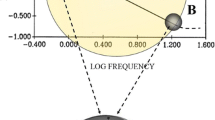Abstract
The search for the low-dimensional attractor behaviour and the dynamic self-organization of neuronal systems, from an analysis of electroencephalographic (EEG) signals, must be carried out under conditions in which the signals are not stationary for more than a few seconds. We employ a technique that we have introduced for analyzing short signals obeying a differential equation and develop it further. The technique uses the fact that in plots of “slope curves” of d log C(r)/d log r against log C(r), C(r)=correlation integral, for short time sequences, the dynamics may be “trans-embedding-scaled”, i.e. a horizontal power-law structure builds up, that is constructed from different slope curves (different embeddings), and appears at the right value of the correlation dimension, although no single slope curve exhibits scaling.
Patterns of the family of slope curves are described exhibiting the “doublet-split-scaling” of the correlation integrals. Examples include a solution of the Mackey and Glass delay differential equation and EEG signals. The two components of a doublet differ in the dimensions of the embeddings of which they are formed, i.e. low- and high-dimensions, respectively. The advantages subsequent to recognizing trans-embedding-scaled correlation integrals and doublet-split-scaling are illustrated for EEG delta sleep signals, with emphasis on ideal doublet-split-scaling. Unambiguous evidence of attractor behaviour in delta sleep is presented.
Similar content being viewed by others
References
Albano AM, Muench J, Schwarz C, Mees AI, Rapp PE (1988) Singular-value decomposition and the Grassberger-Procaccia algorithm. Phys Rev A 38:3017–3026
Atten P, Caputo JG, Malraison B, Gagne Y (1984) Détermination de dimensions d'attracteurs pour différents écoulements. J Méc Théor Appl Special Issue: 133–156
Babloyantz A, Destexhe A (1987) Strange attractors in the cerebral cortex. In: Rensing L, an der Heiden U, Mackey MC (eds) Temporal disorder in human oscillatory systems. Springer Series in Synergetics, Vol 36. Springer, Berlin Heidelberg New York, pp 48–56
Babloyantz A, Nicolis C, Salazar M (1985) Evidence for chaotic dynamics of brain activity during the sleep cycle. Phys Lett A 111:152–156
Cerf R, Ben Maati ML (1991) Trans-embedding-scaled dynamics. Phys Lett A 158:119–125
Cerf R, Daoudi A, Khatory A, Oumarrakchi M, Khaider M, Trio JM, Kurtz D (1990) Dynamique cérébrale et chaos déterministe. CR Acad Sci Paris 311 II:1037–1044
Grassberger P (1986) Do climatic attractors exist? Nature 323:609–612
Grassberger P, Procaccia I (1983) Characterization of strange attractors. Physica 9D:189–208
Mayer-Kress G, Layne SP (1987) Dimensionality of the human electroencephalogram. In: Perspectives in biological and theoretical medicine. Proc. Ann NY Acad Sci 504:62–87
Packard NH, Crutchfield JP, Farmer JD, Shaw RS (1980) Geometry from a time series. Phys Rev Lett 45:712–716
Procaccia I (1988) Weather systems. Complex or just complicated? Nature 333:498–499
Rapp PE, Zimmerman ID, Albano AM, de Guzman GC, Greenbaum NN, Bashore TR (1986) Experimental studies of chaotic neural behaviour: cellular activity and electroencephalographic signals. In: Othmer HG, (eds) Non-linear oscillations in biology and chemistry. Lecture Notes in Biomathematics, Vol 66. Springer, Berlin Heidelberg New York, pp 366–381
Ruelle D (1990) Deterministic chaos: the science and the fiction. Proc R Soc London Ser A 427:241–248
Takens F (1980) Detecting strange attractors in turbulence. In: Rand DA, Young LS (eds) Dynamical systems and turbulence. Lecture Notes in Mathematics, Vol 898, Springer, Berlin Heidelberg New York, pp 366–381
Theiler J (1986) Spurious dimension from correlation algorithms applied to limited time series data. Phys Rev A 34:2427–2432
Author information
Authors and Affiliations
Rights and permissions
About this article
Cite this article
Cerf, R., Oumarrakchi, M., Ben Maati, M.L. et al. Doublet-split-scaling of correlation integrals in non-linear dynamics and in neurobiology. Biol. Cybern. 68, 115–124 (1992). https://doi.org/10.1007/BF00201433
Received:
Accepted:
Issue Date:
DOI: https://doi.org/10.1007/BF00201433




